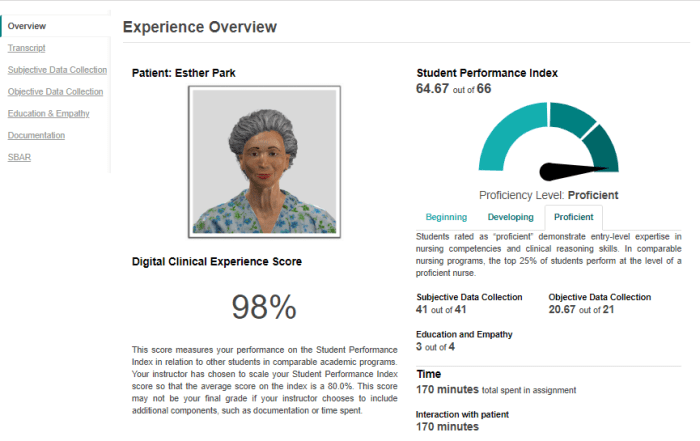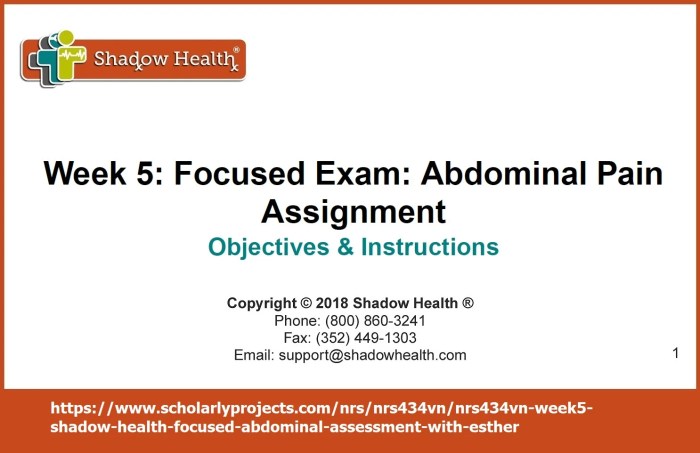Shadow health focused exam abdominal pain – Shadow Health Focused Exam: Abdominal Pain Diagnosis and Management provides a comprehensive overview of the causes, diagnosis, and treatment of abdominal pain. This guide offers a step-by-step approach to evaluating and managing abdominal pain, ensuring accurate diagnosis and effective treatment.
Abdominal pain is a common complaint, with a wide range of potential causes. This guide will help healthcare professionals navigate the differential diagnosis, perform a focused abdominal exam, interpret imaging studies and laboratory tests, and develop an appropriate management plan for abdominal pain.
Differential Diagnoses

Abdominal pain is a common complaint, and the differential diagnosis is broad. The most common causes of abdominal pain include:
- Gastrointestinal disorders (e.g., gastritis, peptic ulcer disease, irritable bowel syndrome, inflammatory bowel disease)
- Genitourinary disorders (e.g., urinary tract infection, prostatitis, endometriosis)
- Musculoskeletal disorders (e.g., muscle strain, hernia)
- Vascular disorders (e.g., mesenteric ischemia)
- Neurological disorders (e.g., radiculopathy)
| Cause | Symptoms | Treatment |
|---|---|---|
| Gastrointestinal disorders | Nausea, vomiting, diarrhea, abdominal cramps | Antacids, antispasmodics, antibiotics |
| Genitourinary disorders | Dysuria, frequency, urgency, hematuria | Antibiotics, anticholinergics |
| Musculoskeletal disorders | Pain with movement, tenderness to palpation | Rest, ice, physical therapy |
| Vascular disorders | Sudden onset of severe pain, nausea, vomiting | Surgery, anticoagulants |
| Neurological disorders | Pain that radiates along a nerve, numbness, tingling | Pain relievers, physical therapy |
It is important to consider the patient’s medical history and physical exam findings when making a diagnosis. For example, a patient with a history of peptic ulcer disease who presents with epigastric pain is likely to have a peptic ulcer.
Top FAQs: Shadow Health Focused Exam Abdominal Pain
What are the most common causes of abdominal pain?
The most common causes of abdominal pain include gastrointestinal disorders such as irritable bowel syndrome, peptic ulcer disease, and inflammatory bowel disease. Other causes include urinary tract infections, gynecological conditions, and musculoskeletal disorders.
How is a focused abdominal exam performed?
A focused abdominal exam involves inspection, palpation, percussion, and auscultation of the abdomen. Inspection involves observing the abdomen for any visible abnormalities, such as distension or hernias. Palpation involves feeling the abdomen for tenderness, masses, or organomegaly. Percussion involves tapping the abdomen to assess for fluid or gas.
Auscultation involves listening to the abdomen for bowel sounds or other noises.
What imaging studies are useful in evaluating abdominal pain?
Imaging studies that may be useful in evaluating abdominal pain include ultrasound, computed tomography (CT), and magnetic resonance imaging (MRI). Ultrasound is a non-invasive imaging technique that uses sound waves to create images of the abdomen. CT and MRI are more advanced imaging techniques that provide more detailed images of the abdomen and its structures.
